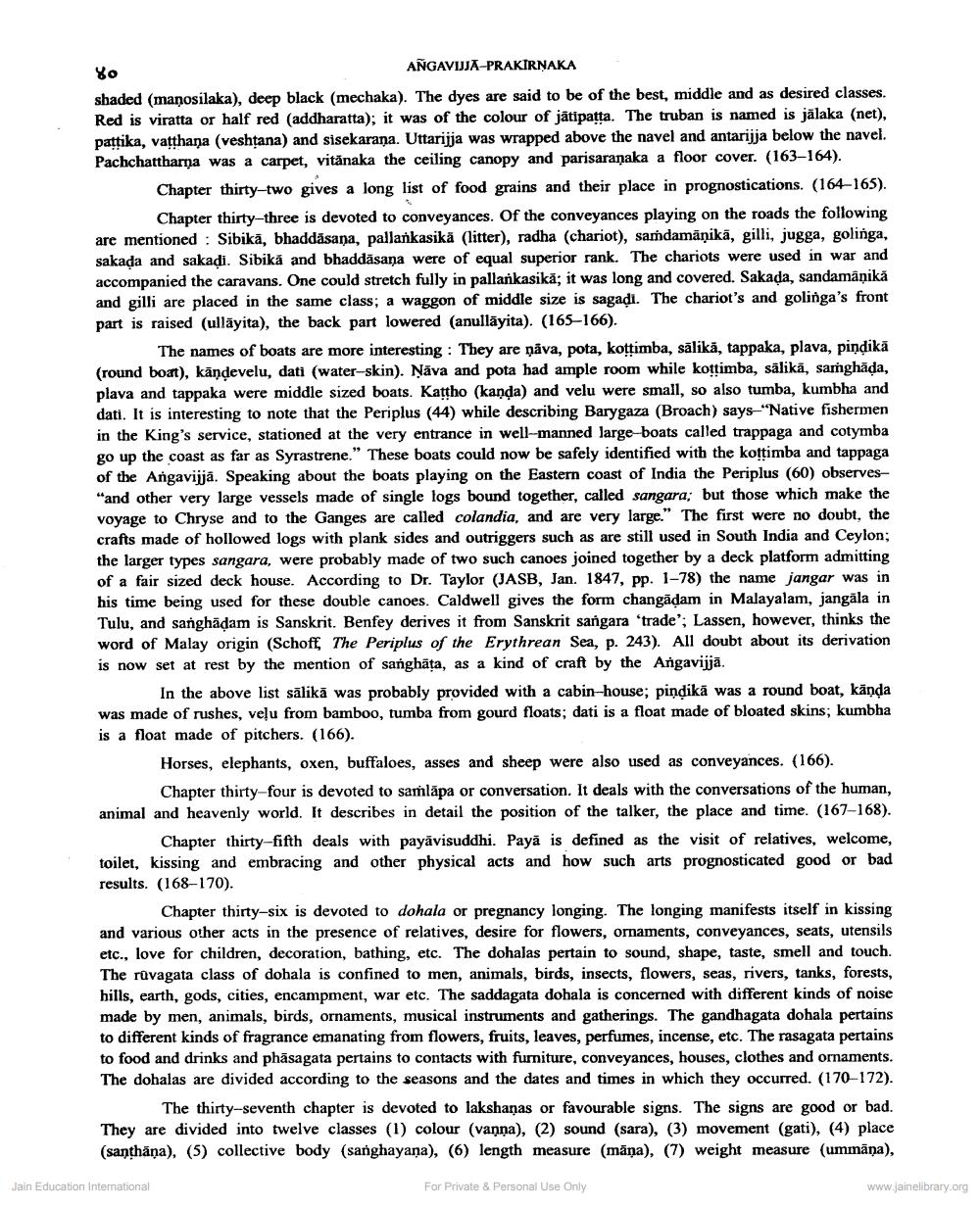________________
80
ANGAVIJJA-PRAKIRNAKA shaded (manosilaka), deep black (mechaka). The dyes are said to be of the best, middle and as desired classes. Red is viratta or half red (addharatta); it was of the colour of jätipatta. The truban is named is jälaka (net). pattika, vatthana (veshtana) and sisekarana. Uttarijja was wrapped above the navel and antarijja below the navel. Pachchattharna was a carpet, vitanaka the ceiling canopy and parisaranaka a floor cover. (163-164).
Chapter thirty-two gives a long list of food grains and their place in prognostications. (164-165).
Chapter thirty-three is devoted to conveyances. Of the conveyances playing on the roads the following are mentioned : Sibikā, bhaddäsaņa, pallankasikā (litter), radha (chariot), samdamāņikā, gilli, jugga, golinga, sakada and sakadi. Sibika and bhaddäsana were of equal superior rank. The chariots were used in war and accompanied the caravans. One could stretch fully in pallankasikā; it was long and covered. Sakada, sandamanikä and gilli are placed in the same class; a waggon of middle size is sagadi. The chariot's and golinga's front part is raised (ullāyita), the back part lowered (anullāyita). (165–166).
The names of boats are more interesting : They are nåva, pota, kottimba, sālikā, tappaka, plava, pindikā (round boat), kandevelu, dati (water-skin). Ņava and pota had ample room while kottimba, sälikä, samnghäda, plava and tappaka were middle sized boats. Kattho (kanda) and velu were small, so also tumba, kumbha and dati. It is interesting to note that the Periplus (44) while describing Barygaza (Broach) says-"Native fishermen in the King's service, stationed at the very entrance in well-manned large boats called trappaga and cotymba go up the coast as far as Syrastrene." These boats could now be safely identified with the kottimba and tappaga of the Angavijjā. Speaking about the boats playing on the Eastern coast of India the Periplus (60) observes "and other very large vessels made of single logs bound together, called sangara; but those which make the voyage to Chryse and to the Ganges are called colandia, and are very large." The first were no doubt, the crafts made of hollowed logs with plank sides and outriggers such as are still used in South India and Ceylon; the larger types sangara, were probably made of two such canoes joined together by a deck platform admitting of a fair sized deck house. According to Dr. Taylor (JASB, Jan. 1847, pp. 1-78) the name jangar was in his time being used for these double canoes. Caldwell gives the form changādam in Malayalam, jangāla in Tulu, and sanghādam is Sanskrit. Benfey derives it from Sanskrit sangara 'trade'; Lassen, however, thinks the word of Malay origin (SchoffThe Periplus of the Erythrean Sea, p. 243). All doubt about its derivation is now set at rest by the mention of sanghāta, as a kind of craft by the Angavijjā.
In the above list sālikā was probably provided with a cabin-house; pindikā was a round boat, kända was made of rushes, veļu from bamboo, tumba from gourd floats; dati is a float made of bloated skins; kumbha is a float made of pitchers. (166).
Horses, elephants, oxen, buffaloes, asses and sheep were also used as conveyances. (166).
Chapter thirty-four is devoted to samlāpa or conversation. It deals with the conversations of the human, animal and heavenly world. It describes in detail the position of the talker, the place and time. (167-168).
Chapter thirty-fifth deals with payāvisuddhi. Payā is defined as the visit of relatives, welcome, toilet, kissing and embracing and other physical acts and how such arts prognosticated good or bad results. (168-170).
Chapter thirty-six is devoted to dohala or pregnancy longing. The longing manifests itself in kissing and various other acts in the presence of relatives, desire for flowers, ornaments, conveyances, seats, utensils etc., love for children, decoration, bathing, etc. The dohalas pertain to sound, shape, taste, smell and touch. The ravagata class of dohala is confined to men, animals, birds, insects, flowers, seas, rivers, tanks, forests, hills, earth, gods, cities, encampment, war etc. The saddagata dohala is concerned with different kinds of noise made by men, animals, birds, ornaments, musical instruments and gatherings. The gandhagata dohala pertains to different kinds of fragrance emanating from flowers, fruits, leaves, perfumes, incense, etc. The rasagata pertains to food and drinks and phāsagata pertains to contacts with furniture, conveyances, houses, clothes and ornaments. The dohalas are divided according to the seasons and the dates and times in which they occurred. (170-172).
The thirty-seventh chapter is devoted to lakshanas or favourable signs. The signs are good or bad. They are divided into twelve classes (1) colour (vanna), (2) sound (sara), (3) movement (gati), (4) place (santhāņa), (5) collective body (sanghayana), (6) length measure (māņa), (7) weight measure (ummāņa),
Jain Education International
For Private & Personal Use Only
www.jainelibrary.org




